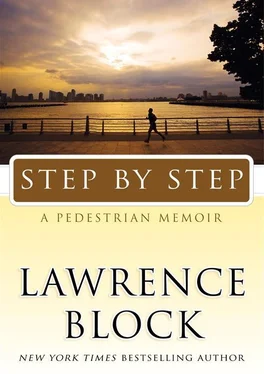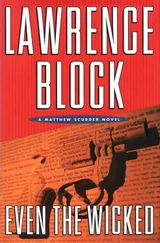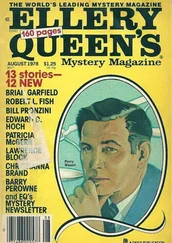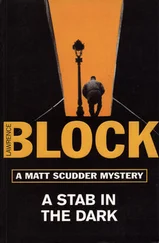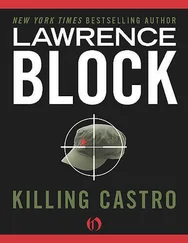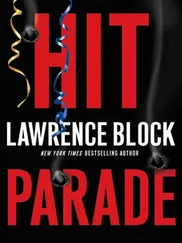Lawrence Block - Step by Step
Здесь есть возможность читать онлайн «Lawrence Block - Step by Step» весь текст электронной книги совершенно бесплатно (целиком полную версию без сокращений). В некоторых случаях можно слушать аудио, скачать через торрент в формате fb2 и присутствует краткое содержание. Год выпуска: 2009, ISBN: 2009, Издательство: William Morrow, Жанр: Биографии и Мемуары, Юмористические книги, на английском языке. Описание произведения, (предисловие) а так же отзывы посетителей доступны на портале библиотеки ЛибКат.
- Название:Step by Step
- Автор:
- Издательство:William Morrow
- Жанр:
- Год:2009
- ISBN:978-0-06-172181-6
- Рейтинг книги:3 / 5. Голосов: 1
-
Избранное:Добавить в избранное
- Отзывы:
-
Ваша оценка:
- 60
- 1
- 2
- 3
- 4
- 5
Step by Step: краткое содержание, описание и аннотация
Предлагаем к чтению аннотацию, описание, краткое содержание или предисловие (зависит от того, что написал сам автор книги «Step by Step»). Если вы не нашли необходимую информацию о книге — напишите в комментариях, мы постараемся отыскать её.
bestselling author comes a touching, insightful, and humorous memoir of an unlikely racewalker and world traveler.
Step by Step — читать онлайн бесплатно полную книгу (весь текст) целиком
Ниже представлен текст книги, разбитый по страницам. Система сохранения места последней прочитанной страницы, позволяет с удобством читать онлайн бесплатно книгу «Step by Step», без необходимости каждый раз заново искать на чём Вы остановились. Поставьте закладку, и сможете в любой момент перейти на страницу, на которой закончили чтение.
Интервал:
Закладка:
“See?” she said. “It was a shortcut. Wasn’t that great?”
“The best part,” I said, “is that we’re still alive.”
“That was fun! And look at all the walking we saved. It was a shortcut.”
“A rabbit shortcut,” I agreed.
It was not our last rabbit shortcut, though it was certainly the most dramatic. Lynne, who as you might gather is not a slave to convention, would often choose a direct if untried route rather than walk in the footsteps of others. Sometimes we saved a few steps. Sometimes we had to turn around and walk back, persuaded of the wisdom of those who had gone before us. But whenever my companion fixed her sights on a rabbit shortcut, we always gave it a shot.
Early on, we stayed in hotels. The refuges for pilgrims — refugios — were only to be found along the traditional route. Each little village had a few hotels, the more reasonable labeled hostal . A room was generally ten to twelve dollars, and while I don’t suppose you’d mistake any of them for the Sherry-Netherland, they were generally clean enough and comfortable enough for a pair of Americans who’d spent the whole day walking dusty roads.
The villages were rarely more than ten miles apart, and my map was reliable when it came to letting us know where the next village was likely to be, so it wasn’t hard to walk far enough to find lodging for the night. The whole system worked fine, until the day it didn’t.
That must have been a day, or maybe two, after we left Huesca and its charming gay restaurant. We were walking in Aragon, heading west, and for the first time we were unable to find a place to stay. The one hostal we managed to locate was fully occupied; a construction crew, temporarily employed in the area, had booked all its rooms for the next two weeks.
The proprietor couldn’t offer a suggestion; as far as she knew, there were no rooms to be found for twenty miles or more. It was far too late in the day for us to cover another twenty miles, and we’d be doing so with no guarantee of a room at the end of the day.
We could sleep in a field, we did have sleeping bags, and I might have given that a shot if I’d been on my own, but I didn’t want to put Lynne through a night under the stars. The sky was clear, so rain wasn’t likely, but it would be uncomfortably cold, and I wasn’t entirely convinced it was safe.
So we hitched a ride. If we’d passed a hostal I might have asked the driver to drop us off, but we didn’t, and he took us clear into Zaragoza. We hadn’t planned to swing this far south, but it was supposed to be a pretty interesting city, with a famous pillar where the Blessed Virgin had made a miraculous appearance on one of her whirlwind retirement tours, so we figured it was worth a look. And it sure beat wandering around all night with no place to stay.
We found a room right away, and we kept it for four days while we had a look around Zaragoza. The room seemed perfectly fine, but as one day led seamlessly into the next, we began to notice, bit by bit, just how filthy that particular room was. The place was a sty, and it took us all that time to realize it, at which point we got the hell out of Zaragoza.
By the time we left Zaragoza — a perfectly pleasant city, our accommodations notwithstanding — we had come to realize the wisdom of hooking up with the traditional route, the famous Camino de Santiago. While we didn’t regret crossing Andorra or walking through Catalonia, it was time for us to get with the program.
So we cheated.
And not for the first time. You’ll recall that we hitched a ride into Zaragoza. And I’ve neglected to mention another ride we took, just a couple of miles, en route from Aix-les-Thermes to the Andorran border. (That was before Lynne was able to believe that walking would get easier; when a car pulled up and the driver offered us a ride, it would have taken a harder man than I to wave him off.)
This time what we did was catch a northbound train out of Zaragoza. I’d worked it out that our best bet was to join the Camino at Puente la Reina, in Navarre, and we could take the train to a town along the way that boasted a parador, one of a group of inns housed in historic properties and operated by the Spanish government. After that pigpen in Zaragoza, we were ready for something a little nicer.
But we were riding a train, and that was cheating.
When I thought about it, it struck me that the whole idea of cheating on a pilgrimage by choosing a faster or easier form of locomotion than walking was wildly anachronistic. A thousand years earlier, when pilgrims from all parts of Europe made their way to Compostela, they didn’t choose a deliberately slow and antiquated method of getting there. On the contrary, they covered the ground as quickly and as comfortably as they could. Most of them walked, not because it was good for the soul but for lack of a horse to ride or a carriage to ride in. The object, after all, was to arrive at the sacred destination and get their sins expunged, not to wear out as many pairs of sandals as possible in the process.
But that was then, alas, and things were different by the time we took off on foot. You could still go to any holy site and call your journey a pilgrimage, and how you get there doesn’t necessarily enter into the equation. The hadjis who make their way to Mecca every year don’t walk there from Indonesia or Pakistan or Dubai. They don’t even ride camels. They take airplanes instead.
For us, though, and for every peregrino we encountered along the route, the destination was the least of it. Santiago de Compostela is a beautiful city, and well worth a visit. But subtract the ordeal, take the long walk out of the picture, and we’d have had no reason to go. Getting there wasn’t just half the fun; for us, it was the whole point.
The train made sense; if we walked from Zaragoza, we’d have a long walk through uninteresting terrain and be unable to find places to stay along the way. Still, it wasn’t what we’d set out to do. It was, well, cheating.
And, from the time we got off that train, we never went anywhere other than on foot until our pilgrimage was complete. Then and only then did we board another train that carried us south from Santiago de Compostela, first to Vigo and then, a day later, to Lisbon.
When the Camino led us to Logrono, for example, we walked in one end of that town and out the other. When we stayed in a city for a few days, as we did in Burgos and León, we passed up cabs and local buses and toured the place on foot. When we were ready to move on, we picked up our packs and walked. Trains, buses, cars, trucks, ox carts — we saw them all, and waved, and kept on walking.
And we never mentioned the cars or the train, not to our fellow peregrinos, nor to our friends and family back home. “You walked all the way?” they’d marvel. “On foot? All the way?”
“Every step of the way,” we agreed.
It was just simpler that way. Why launch into a tedious story of our passage into and out of Zaragoza? All in all, we covered more miles on foot than we would have if we’d started out at Roncesvalles, as most people do, and walked right on through to Compostela. We had all those extra miles from Toulouse, and the great detour through Andorra and Catalonia. All told, we covered something like 650 pedestrian miles. That was plenty, so why bother putting an asterisk in the record book?
But it must have bothered us. Otherwise why would I be writing about it now?
The cathedrals at Burgos and León were quite spectacular, though I can’t begin to remember anything specific about them. We gave them a long look at the time, and spent at least a few minutes in virtually all of the churches we encountered along the way.
Читать дальшеИнтервал:
Закладка:
Похожие книги на «Step by Step»
Представляем Вашему вниманию похожие книги на «Step by Step» списком для выбора. Мы отобрали схожую по названию и смыслу литературу в надежде предоставить читателям больше вариантов отыскать новые, интересные, ещё непрочитанные произведения.
Обсуждение, отзывы о книге «Step by Step» и просто собственные мнения читателей. Оставьте ваши комментарии, напишите, что Вы думаете о произведении, его смысле или главных героях. Укажите что конкретно понравилось, а что нет, и почему Вы так считаете.
